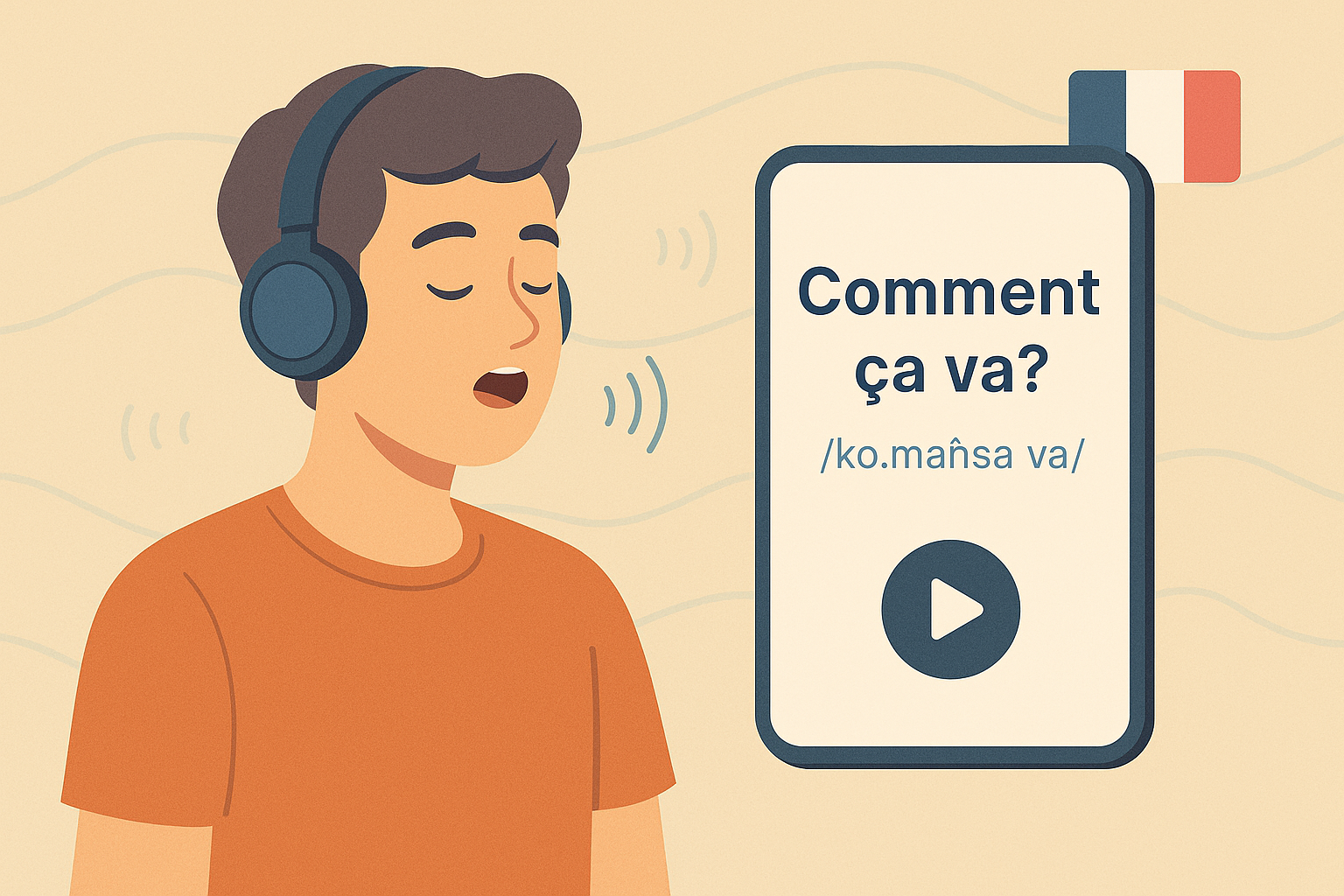French pronunciation & listening (A1–B1) — liaison, rhythm, real-life comprehension
French listening becomes easier when you trust the music of the language—smooth connections, gentle stress, and quiet vowels—so in this guide you will explore liaison, rhythm, reductions, and chunking through simple stories and slow-to-natural lines, building clear habits that make everyday speech feel readable with your ears.

Why French pronunciation challenges English speakers
English speakers learning French face unique listening obstacles rooted in fundamental differences between the languages. English relies heavily on stressed syllables and distinct vowel peaks to convey meaning, while French distributes energy evenly across syllables and connects words through liaison. This contrast creates a perceptual mismatch—your English-trained ear hunts for stress patterns that French doesn’t provide, causing comprehension gaps even when vocabulary knowledge exists.
Understanding French pronunciation mechanics transforms this challenge into manageable skill-building. Instead of memorizing thousands of word pronunciations individually, you learn systematic patterns governing how sounds connect, reduce, and flow together. These patterns repeat constantly in daily interactions—ordering coffee, buying metro tickets, listening to announcements—making them highly practical targets for focused practice.
1) The music of French: what your ear should expect
As an English speaker, you tend to hunt for stressed syllables and big vowel peaks, but French prefers even timing, soft endings, and groups of words that travel together, which is why learning to hear liaison (linking), enchaînement (resyllabification), and quiet final consonants instantly makes fast speech sound calmer and more predictable.
🇫🇷 FR (slow) — Il est / doc-teur / à Paris.
🇫🇷 FR (natural) — Il‿est docteur à Paris. /il‿ɛ dɔktœʁ a paʁi/
🇺🇸 EN — He is a doctor in Paris.
French prosody builds meaning through phrasal units rather than individual words. This explains why direct word-by-word translation often produces confusion—French speakers chunk information differently, grouping determiners, adjectives, and nouns together while treating function words as connective tissue rather than independent elements. Training your ear to recognize these natural groupings accelerates comprehension dramatically.
2) Liaison you will meet every day (A1→A2)
Liaison is the simple habit of pronouncing a usually silent consonant because another word follows with a vowel, and while grammar books give long tables, beginners can focus on a small, reliable set that appears constantly in shops, cafés, and transport announcements.
🇫🇷 FR — Vous‿avez une carte ? /vu.zave yn kaʁt/
🇺🇸 EN — Do you have a card?
🇫🇷 FR — Les‿amis arrivent. /le.zami aʁiv/
🇺🇸 EN — The friends are arriving.
🇫🇷 FR — Un‿ancien ticket. /ɛ̃.nɑ̃sjɛ̃ tike/
🇺🇸 EN — An old ticket.
🇫🇷 FR — Quand‿elle vient. /kɑ̃.tɛl vjɛ̃/
🇺🇸 EN — When she comes.
Common liaison patterns
Three consonants account for most daily liaisons: /z/ after plural markers and “vous,” /n/ after “un” and “on,” and /t/ after “est,” “sont,” and “quand.” Mastering these three covers approximately eighty percent of liaisons you’ll encounter in practical conversations. The remaining liaisons appear less frequently and often in more formal registers.
Liaison serves communicative functions beyond mere aesthetic smoothness. It clarifies grammatical relationships—distinguishing singular from plural nouns, marking subject-verb connections, and signaling compound verb forms. Native speakers process these signals unconsciously while learners benefit from explicit awareness of these patterns and their meanings.
3) Reductions that hide in plain sight (A2)
Native speakers frequently soften or compress function words, and these reductions are not sloppy; they are the normal shape of fluent speech, so train your ear to accept them and your mouth to produce them gently without pushing volume or speed.
🇫🇷 FR (slow) — Je ne sais pas. /ʒə nə sɛ pa/
🇫🇷 FR (natural) — Je sais pas. /ʒə sɛ pa/ (the ne disappears in casual speech)
🇺🇸 EN — I don’t know.
🇫🇷 FR (slow) — Tu es prêt ? /ty ɛ pʁɛ/
🇫🇷 FR (natural) — T’es prêt ? /tɛ pʁɛ/
🇺🇸 EN — Are you ready?
🇫🇷 FR (slow) — Il y a beaucoup de monde.
🇫🇷 FR (natural) — Y’a beaucoup de monde. /ja boku də mɔ̃d/
🇺🇸 EN — There are lots of people.
Use reductions with friends and in informal contexts; in shops or with older strangers, speak a touch more clearly, but keep the rhythm smooth.
Understanding register shifts
Reductions correlate strongly with social context and register. Formal situations—job interviews, official appointments, addressing strangers—favor fuller pronunciations that preserve grammatical markers. Informal settings—conversations with friends, family interactions, casual café chats—employ extensive reductions that streamline communication without losing clarity for native speakers.
Learners navigating these register shifts benefit from receptive competence exceeding productive ability initially. Understanding heavily reduced speech prepares you for authentic interactions while producing moderately reduced speech keeps you comprehensible across diverse social contexts. This imbalance represents normal acquisition patterns rather than deficiency.
4) Chunking: listen for groups, not words
Because French prosody builds meaning in units, you can unlock comprehension by listening for chunks—time, place, action—rather than trying to translate individual words in sequence, which often creates stress and causes you to miss the next phrase.
🇫🇷 FR (natural) — Ce soir à dix-huit heures, le train pour Lyon part voie cinq.
/sə swaʁ a diz‿ɥit œʁ lə tʁɛ̃ puʁ ljɔ̃ paʁ vwa sɛ̃k/
🇺🇸 EN — This evening at six p.m., the train to Lyon departs from platform five.
Announcement comprehension improves dramatically when you anticipate information structure. Transport announcements follow predictable templates: line/service identification, direction/destination, timing information, reason (if delayed), and passenger instructions. Recognizing this template allows you to “pre-listen”—knowing what type of information comes next before the speaker produces it.
Practical chunking exercises
Practice chunking by listening to authentic announcements—train stations, airports, supermarkets—and sketching information boxes: [where] [when] [what] [why]. This visual organization mirrors how French speakers mentally process rapid information streams. After several repetitions, the chunking process becomes automatic, freeing cognitive resources for vocabulary recognition and response planning.
5) Story practice: morning market scene (A1→B1)
Imagine a Saturday market where the air smells of fruit and bread; you are waiting at a small stall, the vendor is joking with a regular, and a brief queue forms behind you, so you breathe once, decide what you want, and let the sentence flow out in one soft, connected line.
🇫🇷 FR (slow) — Bonjour, je voudrais deux pommes, un kilo de tomates, et un peu de basilic.
🇫🇷 FR (natural) — Bonjour, j’voudrais deux pommes, un kilo d’tomates, et un p’tit peu de basilic.
🇺🇸 EN — Hello, I’d like two apples, a kilo of tomatoes, and a little basil.
Notice how je voudrais often relaxes to j’voudrais, how de before a consonant lightly touches or disappears, and how the rhythm stays even, which lets the vendor hear numbers and items clearly, then confirm the price without asking you to repeat.
🇫🇷 FR — Ça fait quatre euros cinquante, s’il vous plaît. /sa fɛ katʁ øʁo sɛ̃kɑ̃t/
🇺🇸 EN — That’s four euros fifty, please.
Building transactional confidence
Market interactions provide ideal pronunciation practice environments. Vendors expect concise orders stated clearly, creating natural pressure without high stakes. The repetitive nature—multiple vendors, similar transactions—allows you to refine pronunciation across several attempts within minutes. This immediate feedback loop accelerates learning more effectively than isolated practice.
6) Story practice: metro announcement (A2)
On a weekday evening, the carriage is crowded and the sound system is a little echoey, yet the announcement remains perfectly logical once you anticipate the template—line, direction, cause, advice—and allow the links to guide your ear from block to block.
🇫🇷 FR (template) — Ligne + numéro, en direction de + terminus, ralentie en raison de + cause, merci de + conseil.
🇫🇷 FR (natural) — La ligne 4 en direction de Bagneux est ralentie en raison d’un incident, merci de laisser descendre avant de monter.
🇺🇸 EN — Line 4 toward Bagneux is delayed due to an incident; please let passengers off before boarding.
7) Polite clarity: repair strategies (A1→B1)
Even with good rhythm, you will sometimes miss a word, so prepare polite, efficient repair lines that keep the conversation warm and moving, which is better than freezing and asking for a full repetition every time.
🇫🇷 FR — Pardon ? Vous pouvez répéter un peu plus lentement ?
🇺🇸 EN — Sorry? Could you repeat a bit more slowly?
🇫🇷 FR — J’ai entendu “voie”… c’est bien voie cinq ?
🇺🇸 EN — I heard “platform”… is it platform five?
🇫🇷 FR — Comment ? La dernière partie, s’il vous plaît.
🇺🇸 EN — Sorry? The last part, please.
🇫🇷 FR — Vous pouvez l’écrire, s’il vous plaît ?
🇺🇸 EN — Could you write it down, please?
Effective repair strategies demonstrate engagement rather than confusion. Partial repetition—confirming what you did understand—shows active listening and narrows the information gap efficiently. This approach feels more collaborative than repeatedly saying “Je ne comprends pas” which places entire responsibility on the speaker to reformulate without guidance about what specifically caused difficulty.
8) Mouth mechanics you can feel (A1→B1)
Switching from English articulation to French is like changing instruments: keep the tongue forward for i, é, round the lips for u, ou, relax the jaw to shorten vowels, and let the back of the throat shape a light, breathy R that never drags; practice quietly first to find comfort, then add voice.
🇫🇷 FR — tu, tout, rue → keep lips rounded; pitié, cité → smile vowels; Paris → light R /paʁi/.
🇺🇸 EN — Round vs smile vowels; short, even beats with a gentle French R.
Physical awareness techniques
Place fingertips lightly on your lips while practicing rounded vowels—you should feel consistent lip protrusion without jaw movement. For front vowels, smile slightly and notice how your tongue rises and advances. These tactile references help establish muscle memory faster than audio feedback alone, particularly for sounds absent in English.
9) Slow→natural pairs you can reuse (A1→B1)
🇫🇷 FR (slow) — Je ne peux pas venir ce soir.
🇫🇷 FR (natural) — J’peux pas venir ce soir. /ʒpø pa vniʁ sə swaʁ/
🇺🇸 EN — I can’t come tonight.
🇫🇷 FR (slow) — Il y a beaucoup de monde.
🇫🇷 FR (natural) — Y’a beaucoup d’monde. /ja boku d mɔ̃d/
🇺🇸 EN — It’s very crowded.
🇫🇷 FR (slow) — Où est la sortie la plus proche ?
🇫🇷 FR (natural) — Elle est où, la sortie la plus proche ?
🇺🇸 EN — Where is the nearest exit?
10) A calming routine for your commute
Choose one short dialogue, whisper the slow version once to place the sounds, speak the natural version twice to feel the flow, then imagine the setting—a platform, a café, a pharmacy—so when reality arrives you already know the melody of your line and your brain is free to notice numbers, prices, or platform changes.
Divided attention practice—speaking while performing another task—simulates real-world cognitive loads more accurately than isolated pronunciation drills. This preparation reduces performance anxiety when actual situations demand simultaneous language production and environmental awareness, such as ordering while managing bags or asking directions while reading signs.
Study glossary (FR → IPA → EN)
| FR | IPA | EN |
|---|---|---|
| Liaison | /ljɛzɔ̃/ | Linking final consonant to next word |
| Enchaînement | /ɑ̃ʃɛnmɑ̃/ | Resyllabification across word boundary |
| Réduction | /ʁedyksjɔ̃/ | Weakening/omission of function words |
| Rythme | /ʁitm/ | Even timing, soft stress |
| Groupe de sens | /ɡʁup də sɑ̃s/ | Sense group / chunk |
| Intonation | /ɛ̃tɔnasjɔ̃/ | Melody of speech |
| Poser sa voix | /poze sa vwa/ | Set your voice calmly |
| Articulation | /aʁtikylasjɔ̃/ | Shaping sounds |
| Écoute active | /ekut aktiv/ | Active listening |
| Réparer (une incompréhension) | /ʁepaʁe/ | Repair a misunderstanding |
| Annonce | /anɔ̃s/ | Announcement |
| Voie | /vwa/ | Platform / track |
| Travaux | /tʁavo/ | Engineering works |
Authoritative references
For pronunciation symbols and examples, consult a reliable dictionary and a phonetics overview that matches your level.
Learn French with Roger, Native French Tutor
Expert instruction with proven teaching methods. Personalized lessons tailored to your goals from A0 to C1.
Weekly Lessons with Roger
Learn with Roger, a native French tutor. Structured curriculum from beginner to advanced.
- Native French speaker from France
- All levels (A0-C1) supported
- Personalized curriculum
- Proven teaching methodology
Trial Lesson with Roger
Experience Roger’s teaching method with a 25-minute trial session. Perfect to get started.
- 25 minutes with Roger
- Level assessment included
- Personalized learning roadmap
- No commitment required
A1 Foundations Guide
Complete beginner’s guide created by Roger. Structured lessons with native pronunciation.
- Step-by-step A1 curriculum
- Audio by native French speaker
- Practice exercises included
- Learn at your own pace
Continue Learning
Check out these related articles

French cinema classics (A1–B1) — learn French through movies
Explore French cinema from the Lumière brothers to modern hits, and learn practical French with friendly A1–B1 lines, IPA, and…

Best online dictionaries for French to English translation — beyond WordReference (A1–C1)
Discover the best online French-English dictionaries beyond WordReference, including specialized tools for context, pronunciation, technical vocabulary, and professional translation that…

French pharmacy phrases (A1–B1) — symptoms, advice, dosage, and OTC help
French pharmacy phrases help you explain symptoms, ask for over-the-counter help, and confirm dosage and side effects. This A1–B1 guide…
👋 Join Our Community
Follow us for daily tips, pronunciation tricks, and free resources
👍 Follow on Facebook